Goal of ATLAS
V-Tron, an expert in sensor technology and data communication, and MST, specialising in sustainable mobility and safety, are joining forces in the ATLAS project to develop a scalable and modular autonomous vehicle platform.
This platform enables both autonomous and remote control by distributing intelligence between vehicles and infrastructure. This approach promotes more efficient and safer logistics and responds to the shortage of drivers and the need to modernise existing vehicles.
ATLAS focuses on the growing demand for safe, sustainable and efficient transport solutions in heavy industry. V-Tron is responsible for sensor technology and digital infrastructure, while MST contributes its expertise in vehicle technology and certification. Together, they are working on an add-on telecommunications system that is crucial for the operation of intelligent infrastructure and autonomous vehicles in mixed traffic environments, such as industrial sites.
ATLAS builds on previous collaborative successes and aims to take the technology to a higher stage of development (TRL 7-8), with an operational prototype being tested in industrial applications. What distinguishes ATLAS from existing systems is its modular architecture, collective perception and autonomous decision-making capabilities, offering flexible and cost-efficient solutions. This innovation makes commercial applications in the logistics sector feasible and provides a response to the strict regulations surrounding autonomous vehicles on public roads.
Project approach
V-tron BV is collaborating with MST Groep B.V. on the development of innovative autonomous transport solutions, focusing on intelligent infrastructure, heavy vehicles and logistics applications.
ATLAS starts with concrete use cases, such as at logistics service provider DPD, and focuses on improving the safety and efficiency of various transport operations. This includes maximising the use of transport vehicles, where people (operators) are normally needed for safety, and automating transport at terminals and distribution centres between locations, both on private property and on public roads.
In developing ATLAS, the emphasis is on using existing infrastructure and equipment, such as a box truck (lorry) platform, in order to maintain sufficient space for loading (containers and the fifth wheel). The behaviour of the system must be simple and predictable and capable of independently resolving various problem scenarios. It also demonstrates that automation as a retrofit of existing vehicles is possible for road safety. This allows transport activities to be taken over, reducing the need for operators/drivers.
ATLAS builds on existing tele-operation technologies. The aim is to eventually deploy the tele-operator as a safety operator, whereby the system operates automatically but can be assisted remotely by humans in extreme cases, and to further develop it towards fully automated driving.
Whereas in the past the focus was mainly on making vehicles smarter, the emphasis is now on adding intelligence to the infrastructure, allowing data to be shared with driver-operated vehicles. This approach offers the possibility of making yard automation scalable for various applications.
Contact V-tron:
Expected results:
All partners within the partnership are capable of generating economic value as a result of the R&D project.
For V-Tron, this results in:
- Establishment of a tele-operator with decentralised infrastructure;
- Intelligent communication between the vehicle and the infrastructure;
- A simplified data communication system that can operate autonomously;
- A data communication system that communicates with other vehicles/operators.
The intelligence in the infrastructure guarantees a long service life for the solution. Replacement vehicles can be easily integrated into the system without high investment costs.
On the vehicle side, this results in:
- Development and integration of Level 4 integrated autonomous telecommunications system;
- Demonstration of a validated and safely tested add-on system of existing techniques, (sub)systems and technologies;
- Development of universal and modular add-on system for various use cases;
- Paving the way for the admission of autonomous (heavy) transport on specified sections of public roads.
Challenges
The most important (innovative) technologies being developed are:
Advanced autonomous control software:
V-Tron will need to develop various AI models (different types of deep neural networks) for:
- Object recognition & classification
- Dynamic route planning and navigation
- Predictive analyses
An essential part of ATLAS is the development of tele-operation, whereby a tele-operator can remotely manage and control multiple vehicles. This offers an efficient way to make more effective use of transport vehicles, which are often stationary 50% of the time. By moving tele-operation to a decentralised infrastructure, a single tele-operator can control up to 15 vehicles simultaneously with collective perception.
Innovative communication infrastructure:
V-tron is developing an innovative communication infrastructure that uses the latest 5G network technologies and edge computing to ensure reliable and fast data transfer between the vehicle, other vehicles and the infrastructure, also known as V2X (Vehicle-to-Everything). Number of key innovative features:
- Low latency and higher reliability;
- Secure data exchange.
By placing data processing closer to the source, latency is significantly reduced, which is essential for real-time decisions in autonomous operations. Edge computing ensures that critical data such as object detection and vehicle statuses are processed locally, while less time-critical data can be sent to a central cloud for further analysis.
The infrastructure utilises advanced encryption techniques and a decentralised network design for data security and integrity. This is particularly important in environments where cybersecurity is a major concern.






















